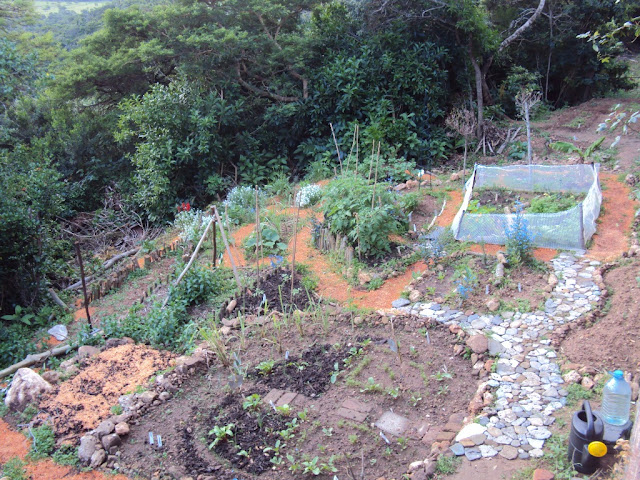From July...
...a wildlife corridor on a steep gradient of hardened soil, rocks and building rubble...
...to November
...a garden in the process of becoming established with climbing and bush beans, various squashes and gourds, tomatoes, onions, carrots, radish, beetroot, cucumber, potatoes, rocket, lettuce, various spinaches, wild mint and other herbs such as oregano, marjoram, parsley, garlic chives, rosemary, lavender, coriander, sage, and basil, banana, wild cherry and guava trees (among others), and a variety of flowers both wild (naturally occuring on the site) and sown from seed
___________________________
All you need is to start on your own doorstep...
 |
spekboom
|
...do lots of walking around the garden, looking, thinking and loads of planning...
...decide what you want to grow and then obtain seed, seedlings and trees...
...start a compost heap and have a compost processing zone...
...an earthworm bin for castings (vermicompost) and nutritious earthworm wee
...you will also need a good pair of gloves...
...and it wouldn't hurt to have a herd of cows walk past your front door every now and then.
...If not, make friends with someone who has a farm and do a trade for manure. And if that isn't possible you can just use your own kitchen scraps, weeds from the garden, cardboard, newspaper and water and create your own soil from scratch!
YOU DO NOT NEED TO HAVE A HUGE GARDEN SPACE TO GROW FOOD. YOU CAN LIVE ON THE 20TH FLOOR OF AN APARTMENT BUILDING IN THE MIDDLE OF THE CITY AND STILL GROW YOUR OWN FOOD.
For more information on how to become more self-sufficient in an energy-efficient and completely non-harmful way please consult any of the sites and organisations listed in our check OUT: box on the right

















































